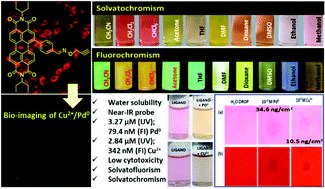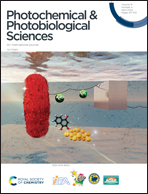Near-IR oxime-based solvatochromic perylene diimide probe as a chemosensor for Pd species and Cu2+ ions in water and live cells†
Abstract
A near-IR perylene diimide probe (OPR-PDI) containing an oxime-propargyl hybrid moiety at the bay position, was designed and synthesized for detection of Pd species and Cu2+ ions in 90% water, the solid state and MG-63 live cells. The aggregation tendency of OPR-PDI in different polarity solvents transmits solvatochromic and fluorochromic properties to differentiate certain organic solvents. Supramolecular aggregates of OPR-PDI in 90% water act as a dual chemosensor for palladium (Pd) species via de-propargylation or hydrolysis of the Schiff-base and Cu2+ ions via complexation with the O/N binding site with a low limit of detection (LOD) of the order of 7.9 × 10−8 M and 3.4 × 10−7 M respectively. TLC strips coated with OPR-PDI can be applied for sensing of Pd0 and Cu2+ ions in the solid state at levels as low as 34.6 ng cm−2 and 10.5 ng cm−2. OPR-PDI imprinted TLC strips could be used as paper sheets for writing coloured alphabets using Pd0 and Cu2+ ions as ink. Moreover, MTT assay showed that OPR-PDI has very low cytotoxicity (IC50 = 230 μM), good permeability, biocompatibility and can be applied for bio-imaging of Pd species and Cu2+ ions in MG-63 cells. DFT calculations, and cyclic voltammetric (CV) and NMR titration studies have also been discussed.



 Please wait while we load your content...
Please wait while we load your content...